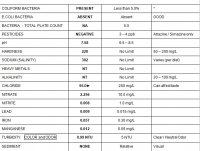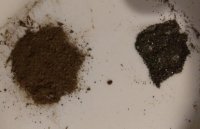Ok, I have much better information now. I think I've been trying to tackle my cartridge filter replacement issue by putting a very fine spin down filter (20 micron) before it. This has led to daily purging of the spin down filter (PIA). The real issue seems to be the lighter sediment as shown in the pics.
Here's the info I have so far:
Pressure tank on/off 32/52 PSI
Well pump flow rate 10 gallons/Minute 10 GPM
I currently have 1" Supply from the pressure tank to 1" Spin Down Filter which will change to 100 mesh (150 micron) that is listed as 20 GPM flow rate.
I've been researching the Fleck 5600 backwash filter (I'm not married to this idea) which has the 3/4" inlet/outlet.
I've chosen filter Ag. I'm not "married" to this media either and after I do a water test. I'm still learning so I just chose Ag and may change but I'm just trying to get an idea of what valve control body/head unit would work with this media.
These are numbers taken from a random website.
Chosen Media
Filter Ag
Tank Flow Rate Backwash Rate
9" / 2.2 / 4
10" / 2.7 / 4.9
12" / 3.9 / 7.1
13" / 4.6 / 8.9
FYI, there are only 2 occupants in my house. I don't see that changing but let's 3-4 occupants with no dishwashers and we work opposite schedules.
I don't know if up-sizing from the 5600 would be a better option.
I've also read you can run these in parallel which would increase my flow rate without increasing GPM back wash requirements.
Here are pictures. I thought I was dealing with a heavy sediment issue but now it appears as though I have more of a lighter sediment issue. Spring time does bring more of the heavier sediment and if the spin down doesn't cut it I will upgrade to a Lakos.
So, my questions are now this:
What size tank (if any) with a 5600/Ag work in my situation?
Would a larger flow control valve work better?
I've also read that running two 5600's in parallel with setting the back wash times on different cycles could be an option as I believe I would double my flow rate without increasing my back wash GPM requirements? (maybe I'm wrong on this)
Thanks for all of the input/suggestions up until this point.
Pic shows there appears to be a higher percentage of light particle vs heavy sediment.
When looking through a glass there seems to also show more light sediment (color of water stays brown) with less specks of larger sediment on bottom of glass.



